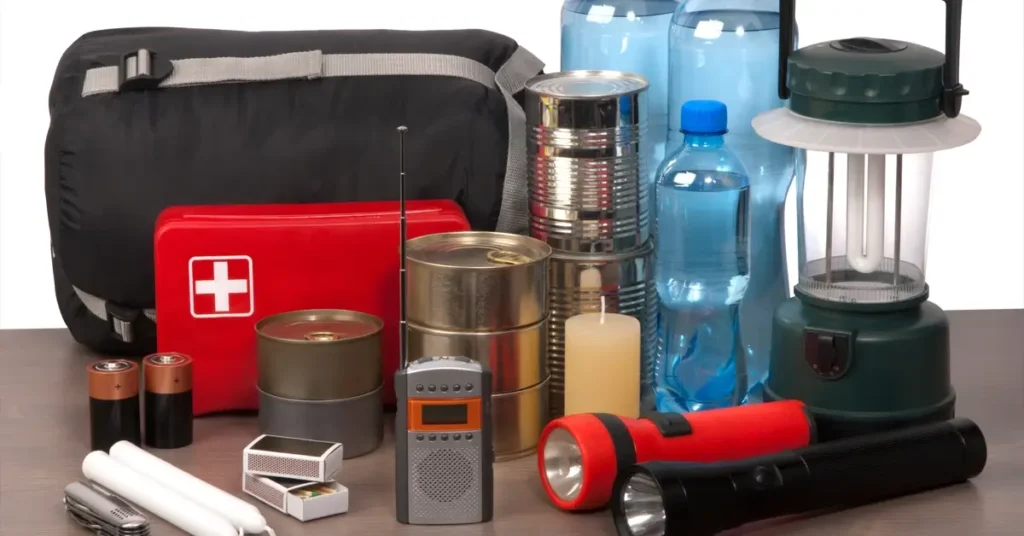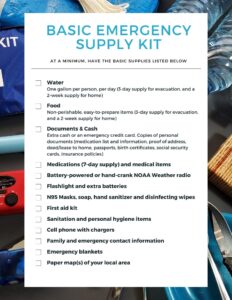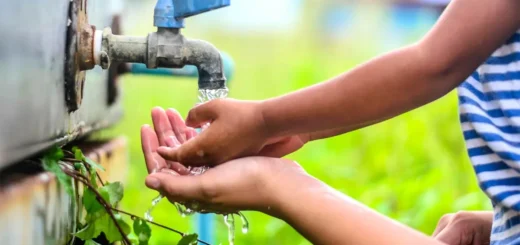Prepping 101: A Beginner’s Guide to Creating A Personal Emergency Readiness Plan

Welcome to our series on Prepping 101! Whether you’re a resident of the Southern United States or planning a visit to this beautiful region, it’s important to be prepared for potential emergencies. The Federal Emergency Management Agency (FEMA), shows that the Southern US is susceptible to a variety of emergencies, including hurricanes, tornadoes, heatwaves, flooding, power outages, and more.
In this Southern Prepper Magazine beginner’s guide, we’ll walk you through the essentials of emergency readiness specific to the Southern US. By the end of this post, you’ll have the knowledge and tools to protect yourself, your loved ones, and your property during unforeseen events.
Throughout this beginner’s guide, we’ll provide you with practical advice and checklists of essential items and preparations to ensure your readiness. We’ve curated information from reputable sources like the American Red Cross, the U.S. Department of Homeland Security, and the National Weather Service.
Table of Contents
Creating Your Personal Emergency Readiness Plan
Having a well-thought-out and pre-existing emergency plan will help to ensure that you and your loved ones can respond appropriately during a crisis.
Step 1: Assess Potential Environmental Risks
Start by identifying the potential risks specific to your state and local area. As we have talked about in other Southern Prepper blog posts, our region is prone to hurricanes, tornadoes, heatwaves, flooding, and other weather-related emergencies. By understanding these common southern environmental risks, you can tailor your emergency plan accordingly.
Step 2: Establish Communication Channels
During any emergency, communication is vital. With today’s ability to communicate instantly with anyone around the world, being cut off from your friends and family is stressful. Being able to communicate with your loved ones and authorities is essential for staying informed, coordinating efforts, and ensuring everyone’s safety.
Here are our top five tips for establishing communication channels:
- Exchange contact information with your loved ones, including phone numbers, addresses, email addresses, and social media accounts. Keep a printed list of these important pieces of information in a secure location in your home.
- Choose a central point of contact, preferably someone who lives outside of your immediate affected area. This person can serve as a relay for communication and provide updates on each family member’s well-being. Make sure everyone in your family knows who this designated contact is.
- Relying on a single communication method can be risky during emergencies when power outages or network disruptions may occur. Use a combination of communication methods such as phone calls, text messages, emails, social media platforms, and even two-way radios or satellite phones to enhance your chances of reaching others.
- Keep a battery-powered or hand-cranked radio in your emergency kit to receive updates from local authorities and news stations. In most cases, your local news channels will be the most reliable source of information during a crisis.
- Conduct periodic communication drills with your family to ensure that everyone understands how to use different communication methods and that your communications devices work. This practice will familiarize everyone with the process and help identify any potential issues or gaps in your communication plan.
Step 3: Create an Evacuation Plan
In certain situations, evacuating your home may be necessary for your safety. In prepper terms, this is called “Bugging out”. Bugging out is a military term that is commonly used in the prepper community that refers to a dangerous situation when you may need to immediately or quickly leave your home.
Deciding when to bug out depends on the specific situation and the guidance provided by your local authorities. Some common scenarios that may warrant bugging out include wildfires, flash flooding, hurricanes, man-made catastrophes, or civil unrest.
It’s important to have a well-thought-out bug-out plan in place before an emergency occurs. Your plan should include predetermined criteria that indicate when it’s time to evacuate. Factors to consider include the severity of the situation, proximity to danger, availability of resources, and the safety of your location.
Living on the Gulf Coast, we bug out to a family home in northern Mississippi when a Hurricane in the Gulf becomes a Category 4 and is showing a path that has the potential to impact our area. Hurricanes are generally slow-moving storms, but are good exercises in bugging out because you need to leave quickly as soon as your criteria are met.
If you are going to leave, leave early or you will be caught in traffic on the major evacuation routes. Use Google Maps to determine an evacuation plan that includes multiple routes and designated meeting points.
Don’t forget about your pets. If you don’t have a relative or friend you can stay with outside of the impacted area, keep in mind that some hotels, VRBOs, and evacuation shelters will not accept pets.
Step 4: Assemble an Emergency Kit
Prepare an emergency kit with essential items that can sustain you and your family for at least 72 hours. Having a three-day supply on hand is a great starting point, but try to increase this to at least a week.
Emergency Supply Checklist
Assembling an emergency kit is a key step in preparedness for any emergency situation. An emergency kit, also known as a “go bag” or “bug-out bag”, contains essential items that can help sustain you and your family during the initial hours or days following a disaster.
Here are some of the most common items for an emergency kit:
1. Container: Start by choosing a sturdy, waterproof bag or container to hold your emergency supplies. Backpacks or duffel bags are popular choices as they are portable and allow for easy transportation.
2. Food and Water: At a minimum have a three-day supply of food per person if evacuating and a two-week supply for home. Pack non-perishable food items that require minimal preparation and do not rely on refrigeration or cooking. Examples include energy bars, canned goods, dried fruits, nuts, and ready-to-eat meals.
Pack or store bottled water and plan for at least one gallon of water per person per day and a three-day supply for an evacuation and a two-week supply for staying home.
3. Medications & First Aid Kit: Having a seven-day medication supply is an important consideration when assembling your emergency kit, especially if you or your family members rely on prescription medications.
- Consult with Your Healthcare Providers: Speak with your healthcare providers, nurse practitioners, or pharmacist about the possibility of obtaining a seven-day supply of your essential medications. They can guide you on whether it’s possible to acquire an extended supply and offer advice on storage and rotation of the medications.
- Refill Prescriptions in Advance: Plan ahead and refill your prescriptions before they run out. Aim to have at least a seven-day supply of medications on hand in your emergency kit. Keep track of expiration dates and ensure that your emergency supply is regularly updated.
- Proper Medication Storage: Pay attention to medication storage requirements. Some medications may need to be stored in a cool, dry place, while others may require refrigeration. Make sure your emergency kit is appropriately organized to maintain the integrity and effectiveness of your medications.
- Include Relevant Medical Information: Along with your medications, include a list of important medical information in your emergency kit. This can include a list of your current medications, dosages, and any specific instructions or precautions. Include the contact information of all your healthcare providers as well.
- Consider Medical Devices and Supplies: If you or your family members rely on medical devices or supplies, such as insulin for diabetes management or inhalers for respiratory conditions, ensure you have an adequate supply in your emergency kit. These items should be regularly checked, maintained, and replaced as needed.
- Rotate and Update: Regularly review your emergency medication supply to ensure it remains up to date. Check expiration dates and replace any expired medications. As you refill your prescriptions, use the medications from your emergency kit and replenish it with fresh supplies.
- Communication with Your Healthcare Providers: During emergency situations, it may be challenging to access medical services or communicate with your healthcare provider. If possible, establish a plan with your provider or their nurse practitioner regarding emergency communication and arrangements for obtaining medications in case of extended disruptions.
In addition to prescription medications, include a well-stocked first aid kit that contains essential over-the-counter medical supplies. It should include items such as bandages, antiseptic ointment, pain relievers, adhesive tape, sterile gauze pads, tweezers, scissors, anti-diarrhea medication, antacids, and allergy relief.
Customize the kit based on your family’s specific needs, including any medical conditions or allergies.
4. Lighting and Communication: Include a battery-powered or hand-cranked flashlight and extra batteries. A battery-powered or hand-cranked NOAA weather radio can also provide you with access to important local news updates and emergency broadcasts. Pack paper maps of your local area and the area you plan on evacuating to.
5. Tools and Supplies: These may include a multi-tool, duct tape, rope, tie-down straps, matches or lighters, a whistle, a utility knife, a can opener, plastic bags for sanitation purposes, and tarps. Additionally, pack hygiene items such as hand sanitizer, wet wipes, toilet paper, paper towels, and personal hygiene products.
6. Documents and Cash: Keep copies of personal documents in a waterproof container or bag. These should include driver’s licenses, government ID cards, birth certificates, divorce documents, custody agreements, power of attorney, social security cards, insurance policies, deed/lease to home, vehicle title(s), passports, medical records, and prescription medication lists. It’s also advisable to include cash and an emergency credit card.
7. Clothing and Bedding: Pack a change of clothes, sturdy shoes, and appropriate weather gear for each family member. Additionally, include blankets or sleeping bags to provide warmth and comfort.
8. Personal Items: Remember to include personal items such as glasses or contact lenses, infant supplies, and any specific items for family members with special needs.
9. Important Contacts and Information: Keep a list of emergency contact numbers, including family members, doctors, and local authorities. Include important addresses and information specific to your emergency plan.
Regularly review and update your emergency kit, ensuring that items are not expired and reflect any changes in your family’s needs. Store the kit in a readily accessible location, and make sure all family members know its location and how to use its contents.
Step 5: Safeguard Your Home Before & During An Emergency
Safeguarding your home is an important aspect of any emergency preparedness plan. If you are new to homeownership, you may be overwhelmed with what to focus on first.
Here are our top tips for safeguarding your home:
- Evaluate your property: Walk around your home and conduct a thorough assessment of your property to identify any vulnerable areas. Do this after a strong storm to help identify any signs of erosion, weak spots in your foundation, cracks in walls, leaks, or areas of pooling water.
- Clear out your surroundings: Trim trees and shrubs near your home to prevent branches from potentially breaking and causing damage during high winds. Secure or remove any loose outdoor items that could become projectiles. Clear gutters and drains of debris to ensure proper water flow and prevent water damage.
- Reinforce windows and doors: Windows and doors are vulnerable entry points during severe weather. If your home does not have storm shutters or impact-resistant windows to shield against strong winds and flying debris, you can custom-cut pieces of plywood to mount onto your windows. Reinforce all entry doors with sturdy locks and bolts. Seal or caulk any gaps or cracks around windows to prevent water infiltration.
- Install backup power: Power outages are very common during emergencies. Take a look at purchasing a backup power source, such as a portable generator or whole-house generator, to keep essential appliances and systems running.
- Maintain home insurance: Review your home insurance coverage to ensure it provides adequate protection in the event of a natural disaster. Understand the terms and coverage limits of your policy. You will probably need additional coverage such as flood, wind, and hurricane insurance if you live around or in coastal areas.
- Create an inventory of your home: Document your belongings by taking photographs or videos of each room, including all valuable items. Keep copies of your important documents, such as insurance policies and receipts, in a secure safe or digitally stored. Your documentation will be valuable for insurance claims in case of damage or loss.
Protecting Your Home During An Evacuation
Once your predetermined criteria that indicate when it’s time to evacuate have been met, it’s go time. Familiarize yourself with the evacuation routes before leaving by checking traffic patterns on Google Maps to decide if alternative routes are needed. Grab your “bug-out bag” with essential items, including important documents, cash, clothing, and personal hygiene products. Remember to include any specific needs for your children, seniors, and pets.
These measures can help protect your property and belongings while you’re away:
- Lock your doors and windows: If you need to evacuate your home, make sure all doors and windows are locked. This includes entry points such as front and back doors, windows, and sliding glass doors.
- Activate your security systems: If you have a home security system, activate it before you leave. Make sure the alarm is set, and notify your security services of the situation. This can help deter potential intruders and ease your mind while you’re away.
- Secure your valuables: Secure valuable items and important documents in a safe or lockbox that is fireproof and waterproof. If you don’t have access to a safe, consider storing them in a secure location somewhere within your home, like a locked cabinet or drawer.
- Safeguard your outdoor items: Move any outdoor furniture, grills, umbrellas, decoration, or other loose items to a secure location. If you can, store them inside your home, garage, or shed. Secure any items that cannot be moved, such as patio furniture, by tying them down or using sturdy covers.
- Unplug electronics: Reduce the risk of electrical hazards by unplugging non-essential electronics and appliances. This can help protect your home from power surges or electrical fires that may occur while you are gone. Leave necessary appliances, such as refrigerators or freezers, plugged in if they contain perishable items.
- Notify trusted Neighbors or friends: Inform trusted neighbors or friends in your local area, about your evacuation plans. Give them your contact information and let them know how long you expect to be away. They can keep an eye on your property and notify you or emergency services of any suspicious activity or issues that may arise.
- Document the condition of your home: Before leaving, take photos or videos of the interior and exterior of your home. This documentation can serve as evidence of the pre-evacuation condition in case you need to file any damage or insurance claims.
- Follow local authorities’ instructions: Stay updated on evacuation instructions provided by local authorities via radio, social media or news reports. Follow their guidance and directives for securing your home, as they may have specific recommendations for when it is safe to return based on the individual emergency situation.
Step 6: Stay Informed and Practice
Stay informed about the weather conditions and any potential warnings or alerts issued by local authorities. Regularly review and update your emergency plan as necessary.
Stay Informed
- Local Emergency Management Agencies: Stay connected with your local emergency management agencies. They provide valuable information about potential hazards, emergency plans, evacuation routes, and community resources.
- Weather Alerts: Sign up for weather alert services in your area. These can include text messages, mobile apps, or automated phone calls that provide timely updates about severe weather conditions or other emergencies.
- News and Media: Stay updated with local news outlets, radio stations, or television broadcasts. They often provide relevant information, emergency announcements, and instructions during crisis situations.
- Online Resources: Utilize reputable websites, blogs, and social media accounts that focus on emergency preparedness and disaster management. These sources can offer tips, guidelines, and real-time updates during emergencies.
Practice Emergency Drills
Plan regular emergency drills and set specific dates and times to practice them. This helps ensure that everyone in the family is familiar with the procedures and knows what to do in different scenarios.
- Shelter-in-place drill: Practice a shelter-in-place drill, which involves staying indoors during a specific emergency, such as severe weather or a man-made incident. Practice seeking shelter in a designated safe area of your home and following necessary precautions. Try making this a fun family experience by setting up a tent in the living room and turning off the lights (or if you are really brave, the internet) for a few hours.
- Communication and check-In: During your drill, practice communication methods with your designated out-of-area contact. Test to be sure that each family member understands how to use the technology and equipment (radio, satellite phone, text message, social media) to check in and provide updates.
- Review and improve: After each drill, think about and chat about what went well and identify any areas for improvement. Make adjustments to your emergency plan based on the outcomes and feedback from your family members.
Conclusion Of Prepping 101: A Beginner’s Guide to Creating A Personal Emergency Readiness Plan
Congratulations! You have now completed the Southern Prepper Magazine Prepping 101: A Beginner’s Guide to Creating a Personal Emergency Readiness Plan. By taking the time to implement the steps outlined in this guide, you have taken your first step toward safeguarding yourself and your loved ones during times of crisis.
Emergency preparedness is an ongoing process, don’t feel like you can do everything in one day. It requires regular updates, practice, and staying informed about potential risks and changes in your environment.
By having a well-thought-out emergency plan, assembling an emergency kit, securing your home, and staying informed, you are better equipped to face unforeseen challenges and protect what matters most (your family!)
As you start and continue your prepping journey, encourage involvement from your family members and loved ones. By having open discussions about emergency preparedness, conducting drills together, and supporting one another you can build a resilient and prepared family and community.
While we hope you never have to face a major emergency, stay proactive, stay informed, and stay prepared. Remember, the more you invest in your preparedness today, the more confident and resilient you’ll be in the face of any adversity tomorrow.
Thank you for joining us in this beginner guide. Stay safe, stay prepared!





